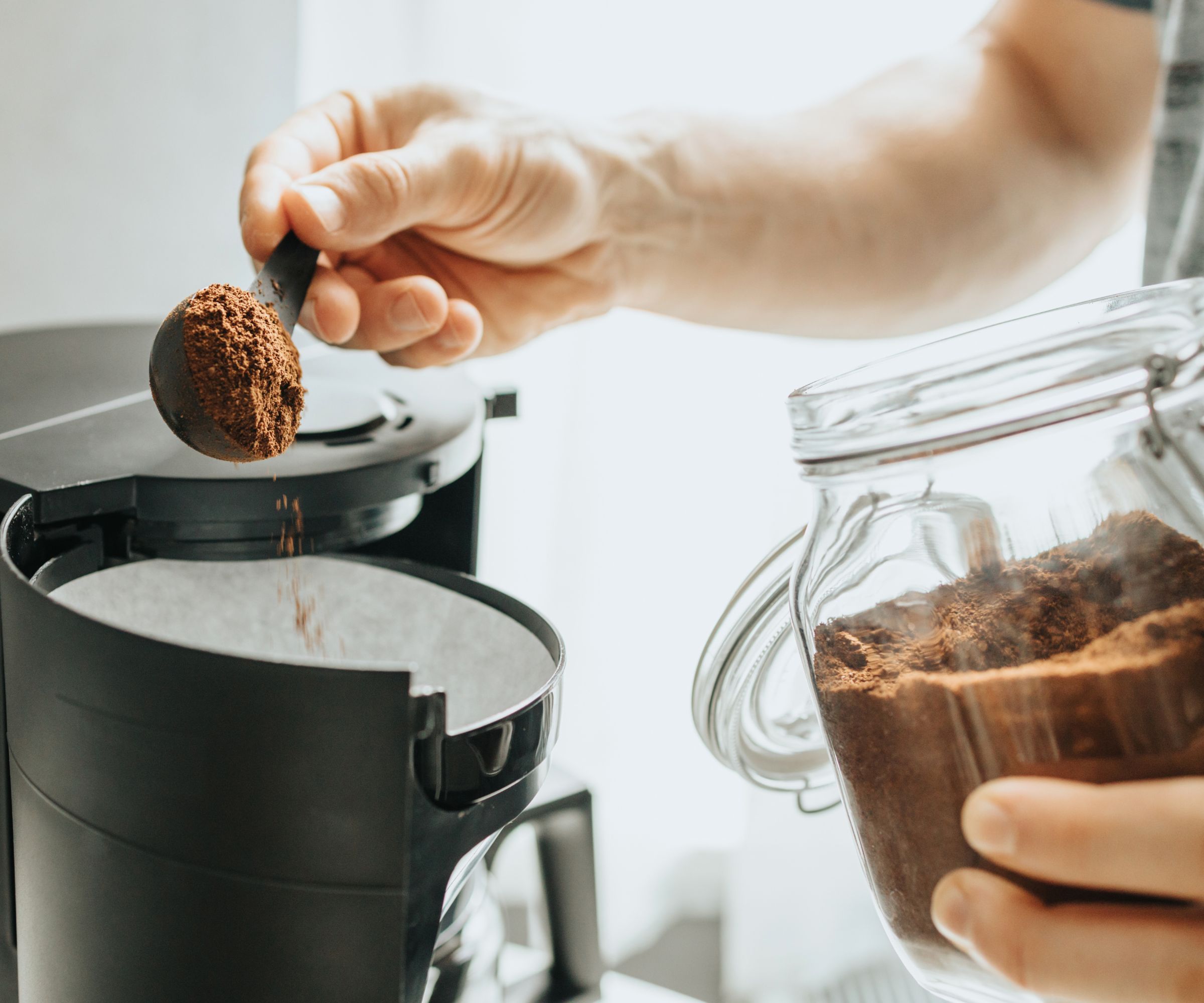How to make drip coffee at home – baristas spill the beans
Here's everything you need to know to make flawless filter coffee at home, including some tips, tricks, and troubleshooting too


As filter coffee is one of the nation's favorite drinks, it's important to know exactly how to make drip coffee at home. A light, delicate, freshly brewed cup can be your motivation for getting out of bed in the morning, your weekend treat, and everything in-between.
As H&G's coffee expert and a former-barista, I've spent the last 9 months testing the best drip coffee makers on the market. I've tested big brands, such as Breville, OXO, and Technivorm, giving every model the best chance to brew a delicious single-serving, as well as a flavorful, family-sized carafe. So, as you can imagine, I've brewed thousands of cups of coffee in my time.
I've spoken with baristas to find out how even the most sensitive coffee drinkers brew their filter coffee. As it turns out, most people follow the same simple steps. They all emphasized the importance of investing in quality beans, one of the best grinders on the market, and a good coffee maker. Once you've established a good grounding, it's hard to make a bad cup of drip coffee.
If you think you'd like something a little lighter and more ritualistic, I've compared making drip coffee to pour-over, to give you a representation of how the best work for each person. However, for now, here's everything you need to make a delicious cup of drip coffee.
Drip coffee essentials

Before we dive deep into the details, you need to have a good drip coffee maker and one of the best coffee grinders to be able to make drip coffee at home. We've tested a range of what's on offer, but these are the three you need to know about.

Our experts have adored the OXO for over two years. It can brew everything from a delicious single-serving to a whole carafe of coffee. This might be a deal-breaker: it doesn't have a hot plate.

Breville's expert drip coffee maker has gotten a lot of love from the experts. It comes equipped with six brewing modes, lots of technical features (including blooming and custom setting), but also a significant price tag.

If you like the finer things in life, as well as an extensive range of color options, you'll love this. It's sleek, durable, repairable for life, and brews delicious coffee. It's expensive too though.
How to make drip coffee

Most drip coffee machines are automated, so you don't really need to lift a finger to enjoy filter coffee. The more technical machine you buy, the more brewing settings you'll have access to.
Thankfully, the basics of most drip coffee makers are the same. You'll need to start with freshly ground coffee. Filter or drip coffee normally demands a medium grind size. Most grinders are generally good around medium grounds. However, if you want our expert recommendation, the Fellow Ode grinder (available at Walmart) is an incredible option. Ashley Palmer-Watts, founder of Artisan Coffee, says 'the biggest thing with getting good coffee is using properly ground beans. You really want a burr grinder, because this will help you achieve a richer and more balanced flavor'.
Design expertise in your inbox – from inspiring decorating ideas and beautiful celebrity homes to practical gardening advice and shopping round-ups.
Bean wise, you can use any type of roast. I particularly like using blonder roasts because you can't use these in espresso machines, so it's great to make the most of blonde, delicate notes where you can. I cannot recommend you trying Ashley's The Smart Cookie roast enough. It's perfect for this kind of coffee.

Ashley spent years as a double Michelin Star chef before turning his hand to coffee. In 2021, he founded Artisan Coffee Co. He's passionate about making coffee simply and to the highest standard. I highly recommend his blonde roast coffee (as well as the other five blends).
Once you've got your coffee sorted, there's a standard recipe to follow. Kayla Stavridis, former barista, says 'the golden ratio for drip coffee is about one to two tablespoons of coffee for every 6 ounces of water.' Although, Kayla says that 'whilst this is a good starting point, you should adjust the coffee-to-water ratio based on personal preference, so you can customise your cup'. That way, you can drink your coffee exactly as you like it.
Kayla adds, make sure you use good water too. 'It's often overlooked, but using filter water to brew your coffee makes a world of difference as well as preventing any scale from building up on heating elements' She also advises that you aim for the water to be between 195°F and 205°F, although your machine will automatically do this for you.
That's really all there is to making drip coffee. If you've ground up the beans and added water to your machine, you'll need to push a few buttons (depending on which model you have) and the machine will do the rest.

Kayla trained as a barista at Starbucks, so she's done her time making delicious coffees. She now works for Barista HQ where she lives, breathes, and drinks all things coffee. She's especially fond of drip coffee, saying 'it holds a special place in coffee culture for its simplicity, consistency, and ritualistic brewing'.
Tips, tricks, and troubleshooting

Whilst cracking the basics is crucial for learning how to make drip coffee at home, if you want to elevate your cup from passable to perfect, here are a few tips, tricks, and some troubleshooting advice from the experts.
The first, most important factor is your drip coffee maker. You'll want to invest in a quality model, because this is the appliance which does all the brewing for you. We have plenty of recommendations in our buying guide for the best drip coffee maker, but you could also look for Speciality Coffee Association (SCA) approval. This tells you that your coffee maker meets a high standard for brewing (the OXO, Breville, and Technivorm which I mentioned above are all SCA-approved).
Steve Spring, expert roaster from Seattle Coffee Roasters, says that it's also important to ensure that you've got evenly saturated beans. He says 'some drip machines do this automatically, but if yours doesn't you might need to pre-infuse or bloom the grounds by adding a small amount of water to them and waiting about thirty seconds before starting the machine'.
Almost all the baristas I spoke with recommended blooming your coffee before hand. Pre-saturating your grounds helps to release any acidic CO2 from your coffee. It'll give you a smoother, sweeter cup every time. Once you've started blooming, you won't go back.
Only brew as much coffee as you will drink. Whilst hot plates are good (and, boy, do I use mine), letting your coffee sit on a hot plate for hours will likely make it taste stale and sour. Steve Spring recommends 'transferring your coffee to a thermal carafe if you know you won't drink it straight away'. That helps you to steer away from any burnt flavors.
Another reason your coffee might taste stale is if you haven't cleaned your filter basket thoroughly. Stray grounds will make your coffee taste bitter or sour. It's important to clean all of your machine, so that scale doesn't build up and other dust and dirt doesn't get in the way of you enjoying a delicious cup of filter coffee.

Steve is passionate about all things coffee (he even owns a coffee roastery) and has a particular penchant for filter coffee. He's brewed hundreds of cups and loves how 'easy and consistent it is, especially for those who want a steady supply of coffee throughout the day.
FAQs
How much coffee do you put in a drip coffee maker?
The golden ratio for drip coffee is one tablespoon of ground coffee for about 3-5 oz of water. This is a good starting point, but you'll want to adjust the quantities of coffee which you add in to suit your taste preferences. Some people like to add more coffee for an intense flavor, others prefer theirs lighter.
It's worth adjusting your grind size if you want to switch-up how much flavor extraction you're achieving. Whilst you should sit around medium grinds, is you opt for a slightly finer setting, your coffee will taste sweeter. A coarser setting will give you a more acidic, bold flavor profile.
How do I make drip coffee taste better?
If you're not enjoying your drip coffee flavors, it's important to check a few things. You should be using good quality coffee beans. Start on a medium roast, but drip coffee is versatile. You can use blonder or darker roasts depending on what you like.
It's also much tastier if you're brewing with freshly ground coffee, from a burr grinder, on a medium grind setting. If this means investing in your own coffee grinder, do it. I promise this little machine will pay you pack endlessly in flavors.
Check your water, because if you're not using filtered water, impurities could be affecting the flavors of your brew too. It will also be damaging your coffee maker.
After all this, clean your machine, check that your filter is clear too and try again. If you are still struggling with the fundamental tastes of your coffee, I've written a whole article on how to make coffee taste better.
Can I make drip coffee without a machine?
It is possible to make drip coffee without a machine, although it will end up looking (and tasting) a lot more like pour-over coffee. If you've been caught short without your drip coffee machine, use medium-grind coffee and steep it with boiling water in a pot. After five minutes, pour this through filter paper and you'll have drip-like coffee.

Laura is our eCommerce editor. As a fully qualified barista, she's our expert in all things coffee and has tested over thirty of the best coffee makers on the market. She has also interviewed Q-Graders and world-leading experts in the coffee industry, so has an intimate knowledge of all things coffee. Before joining Homes & Gardens, she studied English at Oxford University. Whilst studying, she trained as a master perfumer and worked in the luxury fragrance industry for five years. Her collection of home fragrance is extensive and she's met and interviewed five of the world's finest perfumers (also known as 'noses'). As a result of this expansive fragrance knowledge, she always puts quality and style over quantity and fads. Laura looks for products which have been designed simply and with thoughtful finishes.